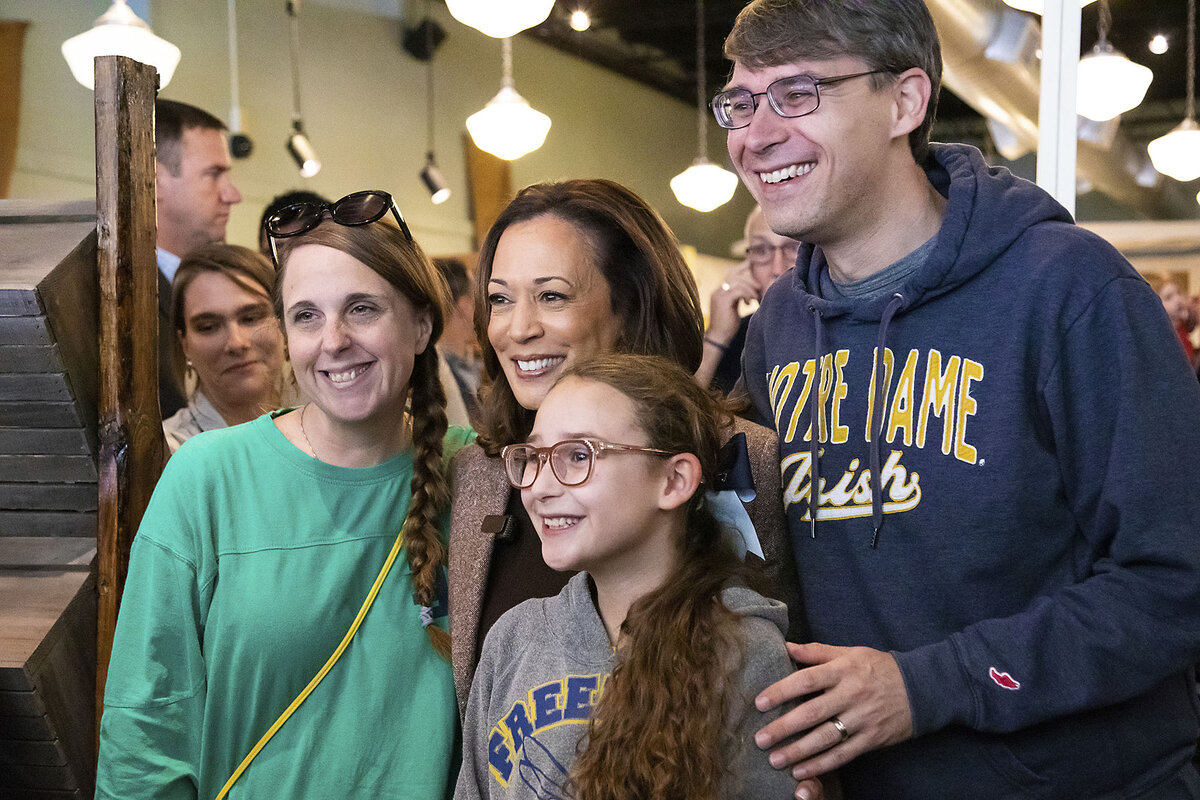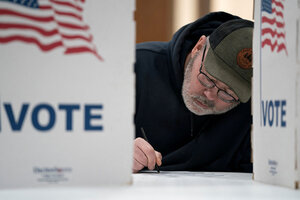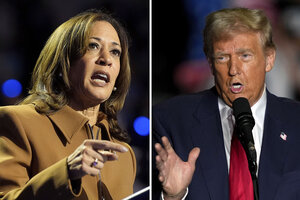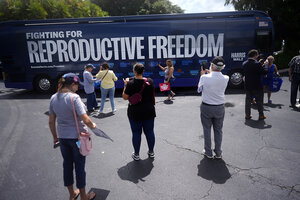How Harris and Trump both put family issues front and center, from IVF to schools
Loading...
While polls show top voter concerns are about the economy and democracy itself, family issues offer a robust catchall for how voters feel about the state of America – and offer the presidential candidates a way to share their visions for the nation. Safety, education, financial security, gender roles, and even immigration all funnel into a family framework.
Candidate family portraits, on full display, are snapshots of modern America.
Why We Wrote This
The Harris and Trump tickets project diverse family portraits that, collectively, represent the United States today. They all share family as a top priority, but their policy approaches diverge sharply.
Former President Donald Trump, a wealthy businessman, has five children from three marriages, two of which were to immigrants. His running mate, Ohio Sen. JD Vance, who grew up on the margins of poverty, has three children from his biracial marriage.
Vice President Kamala Harris, daughter of immigrants, has helped raise two stepchildren in her multiracial marriage. Her running mate, Minnesota Gov. Tim Walz, and his wife relied on fertility treatments to have two children, one diagnosed with a learning disorder.
These portraits project distinct undertones, says sociologist Richard Petts. “The conservative approach is, ‘The government is not going to help, or it’s not our job. Small government, low spending, no public policies. ... We need to go back to the glory days.’ And the more liberal side is, ‘We need to spend tax dollars and provide social supports to people who need it.’”
Family is front and center in the U.S. presidential campaign: Safety, education, financial security, gender roles, and even immigration all funnel into a family framework.
While voters say their top concern is the economy, family life offers a robust catchall for how voters feel about the state of the country – and offers the campaigns a way to share their visions for America.
Just about any issue can be presented as a family issue, says University of Dayton political science professor Christopher Devine. “Whether it connects is different, and maybe a candidate’s success at doing that could relate to his or her ability to speak about their relationships within their own family.”
Why We Wrote This
The Harris and Trump tickets project diverse family portraits that, collectively, represent the United States today. They all share family as a top priority, but their policy approaches diverge sharply.
The candidates’ family portraits, which they’ve put on full display, are snapshots of modern America.
Former President Donald Trump, a wealthy businessman, has five children from three marriages. His spouse and one of his former wives are immigrants. His running mate, JD Vance, who went from the margins of poverty in small-town Ohio to the U.S. Senate with a combination of grit and his grandmother’s determination, has three children from his biracial marriage.
Vice President Kamala Harris is a daughter of immigrants – a scholar and a scientist – and has helped raise two stepchildren in her multiracial marriage. Her running mate, Tim Walz, and his wife of 30 years relied on fertility treatments to have their two children, one of whom is diagnosed with a learning disorder.
These portraits have distinct undertones, says sociologist Richard Petts. “The conservative approach is, ‘The government is not going to help, or it’s not our job. Small government, low spending, no public policies. ... We need to go back to the glory days.’ And the more liberal side is, ‘We need to spend tax dollars and provide social supports to people who need it.’”
Bipartisan support for better schools and child tax credits
The campaigns agree on certain aspirations: supporting working families with things like the Child Tax Credit and paid family leave; creating safe communities; and helping families who want them to have more children. Both acknowledge a need for families to feel economically stable, for students to attend well-resourced schools.
The Child Tax Credit has shaped up to be a central talking point with strong bipartisan support – but the candidates’ approaches have stark differences.
Mr. Trump’s platform calls for permanent implementation of his own Tax Cut and Jobs Acts, which Congress passed in 2017 and expires next year. That doubled the maximum Child Tax Credit from $1,000 to $2,000, raised income thresholds for reducing the tax credit, and allowed for a portion of it to be refunded to families whose tax bills came in under the credit. It also added smaller tax credits for older teens living at home and full-time college students, and for older dependent parents.
Critics say that this version of the credit helps higher-earning parents who don’t need it – and that qualifications exclude the poorest parents, who need it desperately.
For his part, Senator Vance has said he’d like to see a large bump – from $2,000 per child to $5,000 – with no income thresholds.
Ms. Harris’ proposal would raise the tax credit based on a child’s age: to $6,000 for newborns, $3,600 for children under 6 years old, and $3,000 per child ages 6 to 17. And it could be in the form of a refund, which benefits families with the lowest incomes. But it is expensive, by one estimate costing $1.6 trillion over 10 years.
Tax credits can be helpful, say experts – but they’re not a replacement for other supports.
Paid family leave support for working parents
Policies around working parents and family caretakers illustrate the candidates’ divergent family portraits.
Mr. Vance’s controversial remarks about leaning on grandparents to care for children and his comments about the “civilizational crisis” of low birth rates vis-à-vis “childless cat ladies” show the broad differences between the tickets on family issues. The Republican emphasis is on married, heterosexual, two-parent households with children – versus all types of families for the Democrats.
“The cat lady comment was really articulating a sort of traditional – and offensive to many people – view of family life,” says Joel Goldstein, a vice presidential scholar at St. Louis University. “It provoked a lot of discussion and pushback.”
Despite polarization on family matters, “Americans have generally been moving toward an idea that people should have the right to divorce, should have the right to make decisions about working,” says sociologist Stephanie Coontz, director of research and public education at the Council on Contemporary Families. Surveys from the 1970s and 1980s show people thought working mothers could not be good parents, she adds. “That has just been transformed.”
As of last year, nearly 33 million families had children under 18 at home. Among those with married parents, more than two-thirds have both parents working. Those percentages go up for single parents – 89% of unmarried fathers work, as do 77% of unmarried mothers.
Nearly 86% of American voters in a Morning Consult survey say the U.S. economy would be stronger with federal policies that make it easier to work and care for loved ones. And both candidates have plans for that.
During his presidency, Mr. Trump implemented paid family leave for federal workers – up to 12 weeks to care for a newborn or close relative, and his current platform proposes tax credits for unpaid family members who care for loved ones full time.
Paid family leave is a priority for the Harris-Walz team. Ms. Harris has said she wants to expand the federal program to all workers, and as governor, Mr. Walz implemented 20 weeks of partially paid family leave in Minnesota.
As the cost of child care increases, Ms. Harris suggests no family should pay more than 7% of their income for it – an idea that was included with President Joe Biden’s unsuccessful Build Back Better plan in 2021.
On education, which is largely controlled at the local level, candidate Mr. Trump emphasizes parental rights and school choice – meaning that parents should be able to influence educational curriculums, determine their children’s in-school gender identity, and redirect tax funds to subsidize private schooling. He has also proposed eliminating the Department of Education.
Ms. Harris, who is backed by several unions representing educators, has said she will fight attempts to pull public funding from public schools. Her choice of Mr. Walz, who has deep roots in Minnesota’s public school system, where he met his wife who was also a teacher, implicitly speaks to her belief in that system. And Minnesota’s policies to help students – like universal free lunch – align with her vision of offering broad government supports.
A modern view of fatherhood
At one moment during their debate, Governor Walz and Senator Vance connected over gun violence: When Mr. Walz said his son had witnessed a shooting, Mr. Vance offered an audible show of empathy. From there they diverged, with Mr. Vance calling for greater security measures and attention to mental health and Mr. Walz pitching stronger limits on the types of guns on the legal market.
Families on the campaign trail are nothing new. Candidates have long stood alongside their spouses and children to launch their campaigns, and at stops along the way to Election Day. But the way Mr. Vance and Mr. Walz talk about fatherhood is particularly modern, says Professor Petts, who specializes in the role of fathers.
“It’s much more accepting for fathers to be seen as loving and caring and involved and not just this passive secondary parent,” he says, talking about progress in the way society views fathers. They’re now expected “to be not only involved and connected, but to be emotionally involved in their family life.”


















